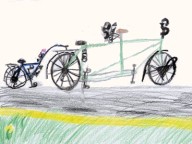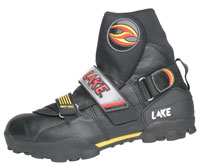

The Lake Winter Shoe looks like a small boot.
Having converted to clipless pedalling in October 2003 and riding year round in Canada, I went looking for cycling footwear that would work both on and off the bike. For me, the ideal footwear should work with SPD pedals, should be comfortable both while cycling and while walking... and should be warm enough for winter conditions. So while booties might work for people who ride straight to and from their garage, the hole in the bottom makes them totally unsuitable for walking outdoors in snow, sleet, ice, etc.
You should try them with an extra pair of socks. My regular shoes are 10 1/2 A (North American sizing), which is the equivalent to a narrow 44 in European sizing. My Summer cycling shoes are Shimano 44 shoes (and Shimano summer shoes are narrower than Lake summer shoes). I bought size 45; the shoes are slightly loose with 2 pairs of socks, yet not too loose for walking; conversely, I have enough room to add a third pair of socks should I need it. By the way, I also tried the 46, but they were way too loose.
I call them “shoes” but wonder whether or not I should call them “boots”. They are actually made of two boots inside each other. The inside one is a neoprene bootie: very flexible and comfortable; when they are new, the shoes would be easier to don if the bootie had a full opening in front (would it be as comfortable or as warm?). They say “practice makes perfect”, and they definitely become easier to don after one or two weeks. For those who wonder, donning these winter shoes takes less time than donning a pair of summer shoes, booties and gaiters, but it takes more time than simply donning rubber overshoes over dress shoes.
The footwear covers the ankle, yet is fairly flexible in that area. The ankle is obviously not as flexible as it is with summer shoes, but it is much more flexible than it would be with, say, Sorel boots or work boots. It took me a couple of days to get used to that aspect of the ride (I tend to ankle a bit), but I now find I can ride without feeling I have heavy or bulky footwear, whereas before I only wore shoes and rubbers -- never winter boots. Once I got used to them, I could say they really are unobtrusive and they feel as close to summer shoes as one may get.
Moreover, they also are comfortable for walking. I prefer slightly tighter shoes for walking than for cycling, so one may need to tighten the straps before walking long distances.
Even though the MXZ300 are great shoes, a few minor improvements would make them a better.
– Buy them large enough to be able to wear 2 pairs of socks without feeling tight. If you can’t wiggle your toes, they are too tight for cycling in winter
– Position the cleats properly and do a few trial rides to make sure they are.
– Use Shoe Goo (or a similar sealant) to seal off the 2 sliders into which are bolted the cleats. When you do that, make sure you don't pack the cleats with glue (gluing from inside works fine). Let the shoes dry 24-48 hours.
– If you have enough vertical clearance inside the shoe, you might even install a fine layer of rubber between the plastic sole and the insole (a split tube works fine).
They clearly are designed for wintry conditions. For instance, the shoes are high enough so my trousers touch them. No freezing ankles and no need for gaiters. A definite plus for winter.
The insole is thick, provides good insulation and fully covers the cleat area. No draught coming in from the cleats and no heat sink effect either. The top is also tight and protects the feet quite effectively.
However everything isn't perfect. For instance, while the sole is made of plastic and probably is waterproof, the cleat area isn't sealed: a major design flaw, I think. Unless something was missing in the box (and I doubt it), Lake doesn't even provide a "rubber seal" à la Shimano. I guess they think that snow is always dry... Anyway, I solved the problem by applying Shoe Goo around the cleats and in the slots (make sure to keep the cleats clean).
As fixed, the soles are waterproof, but one would need to apply leather protectant if one walks a lot in slushy snow. On the other hand, using leather instead of plastic makes the shoes more breathable. Likewise, I wonder how these shoes would behave for a full day ride at 0 C in a mixture of sleet, rain, icing rain, etc. (i.e. really wet stuff falling from above and coming up from below). Would one's feet get soaked?
The sole has good sculptures that seem to work well in various types of snow. Lake used a hard rubber for durability, but this “feature” also makes the soles more slippery on ice than plain old-fashioned rubber overshoes. Lake also supply a set of spikes that may be attached to the front of the boots; I think they could be good for offroading on ice crust, but for walking on ice, spikes under the heel would be better. Spikes are optional: you either install the spikes or leave the flat rubber-coated bolts in place.
All in all, the design is very good, leaning towards “outstanding”, but there still is a bit of room for improvement.
I have used them for commuting and other errands at temperatures going from 0°C down to -28°C. Only once did I feel the cold (nothing serious): it was -28°C and travelled for 45 minutes facing a strong headwind. However, I had two pairs of regular socks. I would have improved greatly their performance if I had used thermal or other high-tech socks. I feel I can ride for an indefinite amount of time if it's warmer than -20°C. And indeed, I have done a few 5-6 hour trips (without going inside at all) at -10 to -15°C.
Waterproofness could be an issue. Some people say they didn't have a problem riding offroad at -30 or -40°C when they hit a stream, but I suspect that it was so cold that stream water froze before they got wet feet. But with the unsealed soles, I suspect they will feel the water if they cross a stream at 0°C, and I know I have felt some dampness when walking in sleet and puddles at 0°C. No problem, however, once I sealed the SPD-cleats slots.
For people who freeze easily or live in a very cold climate, another possible improvement might be to install a rubber insole under the supplied insole. It would be easy to make one from an old mountain-bike tube. The rubber would provide a bit of additional insulation. I haven't tried it.
Lake MXZ300 shoes definitely are made for winter. And for real, serious winter conditions. They are expensive but should last long (I read comments ranging from 5 to 8 years; only time will tell). They are appropriate for commuting, whether one commutes only by bike or with a cocktail of cycling, walking and bussing, but they are equally appropriate for long full-day rides, whether on roads or on trails. Their only real limitation would be riding in heavy rain, in spring-like conditions, but real icebikers know that it shouldn't rain in winter, right?
So the real question should be whether one wants to ride clipless in winter. On my bicycle, I have a set of Shimano SPD-515 pedals (they are now replaced by the 520s) that tend to work fairly well in snow. They sometimes clog in wet snow and prevent clipping in, but even when they don’t clip, the shoes stay fairly well in place. Besides, a good tap is usually all one needs to unclog them. More importantly, I never had any problem unclipping because of snow or ice.
But should one want to ride clipless? People who ride only short rides in winter are well served with normal winter footwear and either flat pedals, toe clips or Powergrips. And people who live in Whitehorse, Yellowknife or Anchorage might prefer polar boots because they are warmer (so they would have to use flat pedals, toe clips or Powergrips). But for people who ride any significant distance in winter, the MXZ300 shoes are confortable, lightweight and warm enough to provide a comfort and performance level that is fairly close to what one gets in summer with clipless pedals.
© 2005 — Updated on: 2010-08-16
Vous voulez me contacter ? Voici l’adresse : You want to reach me? Send-me e-mail:
Maquette et conception du site : Site design: Michel Gagnon